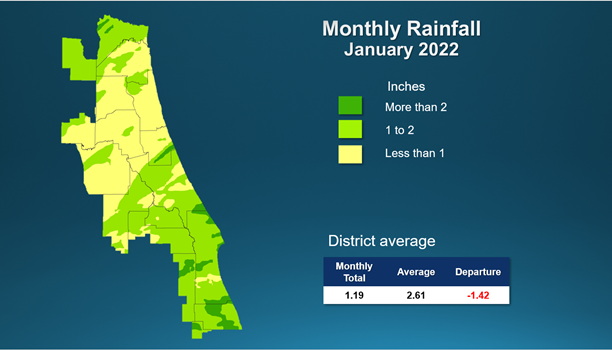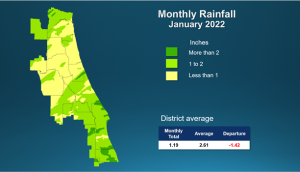Below-average rainfall Districtwide in January

A map illustrates rainfall conditions in December across the St. Johns River Water Management District.
PALATKA, Fla., Feb. 8, 2022 — January brought well below average rainfall to the region, with Marion County receiving the least amount of rain for the month at .83 inches. The Districtwide total of 1.2 inches is less than half the average rainfall for January.

A map illustrates rainfall conditions in December across the St. Johns River Water Management District.
A full report outlining January’s hydrologic conditions was presented at the District’s Governing Board meeting Tuesday. Highlights include:
Rainfall
- Districtwide, January rainfall averaged 1.19 inches, which is 1.42 inches below the average for the month.
- The county with the highest rainfall total was Indian River, which received 1.9 inches of rain.
- Districtwide, the cumulative rainfall total for the past 12 months is 52.33 inches, which is 1.32 inches above the long-term average.
Groundwater
- Upper Floridan aquifer conditions (groundwater levels) at the end of January were a mix of high and normal conditions across most of the District. In the central region, water levels in many of the wells decreased more than 10 percentile points.
- Groundwater levels are at the 69th percentile Districtwide. This means that since 1980, aquifer levels have been higher than they currently are about 31 percent of the time.
Surface water flows
- On Feb. 1, flow in most stations across the District was in the average range. The two exceptions were the Wekiva River near Sanford and the St. Johns River near Jacksonville, where flow was in the low range for this time of year.
- On Feb. 1, flow in the St. Johns River’s headwaters at the Melbourne station was 180 million gallons per day (mgd) (54th percentile).
- Flow in the Econlockhatchee River near Chuluota was in the average range at 101 mgd (65th percentile).
- Flow in the Wekiva River near Sanford was in the low range at 126 mgd (10th percentile).
- Flow at the St. Johns River DeLand station was in the average range at 1,935 mgd (73rd percentile).
- Flow in the Ocklawaha River, the largest tributary to the St. Johns River, was in the average range at 509 mgd (40th percentile).
- Flow at the St. Johns River near Satsuma station was in the average range at 3,335 mgd (51st percentile).
- Flow in the St. Marys River near Macclenny was in the average range at 147 mgd (39th percentile).
Lake levels
- Lake Brooklyn water levels decreased 0.5 foot to 100.3 feet in January and remains below average.
- Lake Weir water levels decreased 0.2 foot to 53.4 feet last month.
- Lake Apopka water levels decreased by 0.1 foot to 65.7 feet in January. Lake Apopka is part of a system with water control structures that are operated by the District.
- Blue Cypress Lake levels decreased to 22.5 feet. Blue Cypress is also part of a system with water control structures that are operated by the District. During April and May, the regulation schedule levels drop in preparation for the summer wet season.
Spring flows
- The mean monthly flow at Silver Springs decreased to 733 cubic feet per second (cfs), or 474 mgd, which is a 25 cfs decrease from December’s mean.
- At the Blue Spring station in Volusia County, the mean monthly flow was 151 cfs, or 97 mgd.
- At Rock Springs, the monthly mean flow decreased 1 cfs to 59 cfs (38 mgd), which is in the normal range for January.
- Mean monthly flow at Wekiwa Springs decreased slightly to 60cfs (39 mgd), which is in the low range for the time of year.
To learn more about rainfall totals and other hydrologic data collected, visit sjrwmd.com.
Visit WaterLessFlorida.com for tips to help landscapes thrive while saving water and money. During fall and winter months, Florida lawns and landscapes need less water and watering restrictions allow for up to one day per week on designated days. Follow the water conservation conversation at #sjrwmd #waterconservation #savewater.

